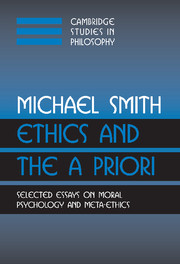Book contents
- Frontmatter
- Contents
- Preface
- Sources
- Introduction
- Part One Moral Psychology
- 1 Internal Reasons
- 2 The Incoherence Argument: Reply to Schafer-Landau
- 3 Philosophy and Commonsense: The Case of Weakness of Will (co-authored with Jeanette Kennett)
- 4 Frog and Toad Lose Control (co-authored with Jeanette Kennett)
- 5 A Theory of Freedom and Responsibility
- 6 Rational Capacities
- 7 On Humeans, Anti-Humeans, and Motivation: A Reply to Pettit
- 8 Humeanism, Psychologism, and the Normative Story
- 9 The Possibility of Philosophy of Action
- Part Two Meta-Ethics
- Index
7 - On Humeans, Anti-Humeans, and Motivation: A Reply to Pettit
Published online by Cambridge University Press: 04 December 2009
- Frontmatter
- Contents
- Preface
- Sources
- Introduction
- Part One Moral Psychology
- 1 Internal Reasons
- 2 The Incoherence Argument: Reply to Schafer-Landau
- 3 Philosophy and Commonsense: The Case of Weakness of Will (co-authored with Jeanette Kennett)
- 4 Frog and Toad Lose Control (co-authored with Jeanette Kennett)
- 5 A Theory of Freedom and Responsibility
- 6 Rational Capacities
- 7 On Humeans, Anti-Humeans, and Motivation: A Reply to Pettit
- 8 Humeanism, Psychologism, and the Normative Story
- 9 The Possibility of Philosophy of Action
- Part Two Meta-Ethics
- Index
Summary
In “The Humean Theory of Motivation” (hereafter HTM) I argued for the thesis that R at t is a motivating reason of an agent A to Φ if and only if there is some Ψ such that R at t consists of a desire of A to Ψ and a belief that were he to Φ he would Ψ. I called this “P1.” I claimed, further, that P1 is definitive of the Humean theory of motivation.
The argument I gave for P1 was relatively simple (HTM: 50–8). It is a commonplace that when an agent has a motivating reason to Ψ his reason is partially constituted by a state that embodies his having Ψ-ing as a goal. But how does this map on to talk of beliefs and desires? Well, what belief and desire are may uncontroversially be characterized using the metaphor of directions of fit. Beliefs are states that aim to fit the world, whereas desires are states that aim to have the world fit them. This metaphor can be rendered non-metaphorical in terms of a functional analysis. Thus, very roughly, the belief that p is a state that tends to go out of existence in the presence of a perception that not-p, whereas the desire that p is a state that tends to endure in the presence of a perception that not-p, disposing the subject to bring it about that p. Now having Ψ-ing as a goal is also a state that aims to have the world fit it. It too must therefore be a disposition to realize Ψ-ing.
[…]
- Type
- Chapter
- Information
- Ethics and the A PrioriSelected Essays on Moral Psychology and Meta-Ethics, pp. 136 - 145Publisher: Cambridge University PressPrint publication year: 2004



